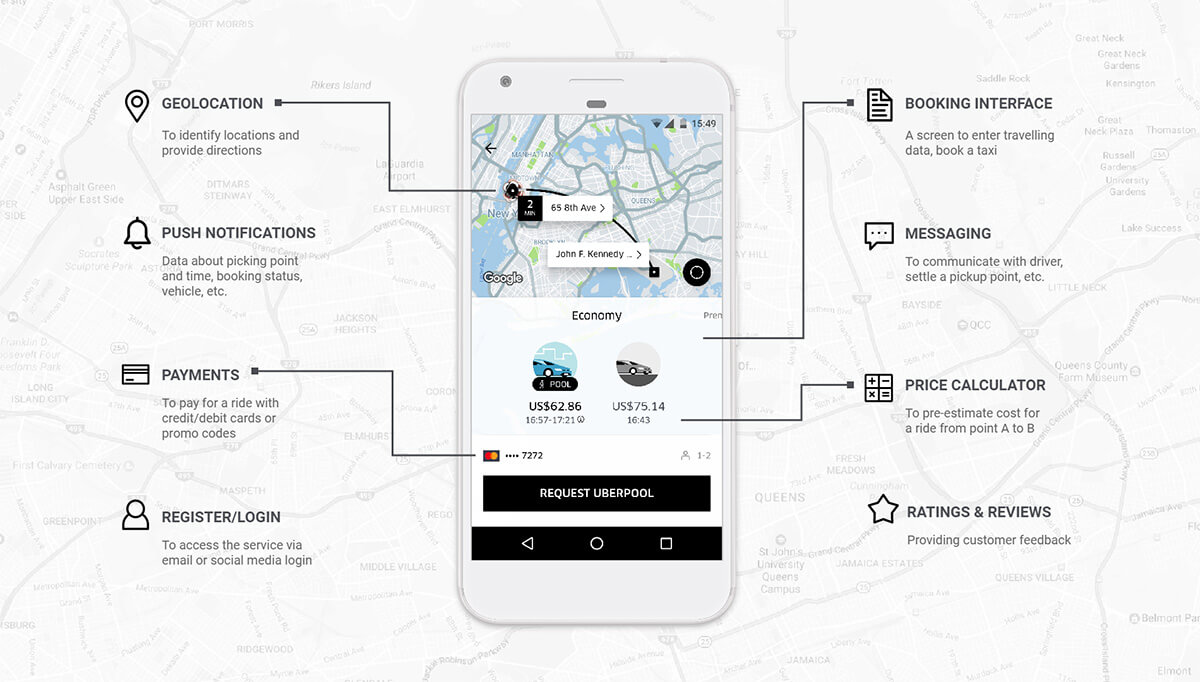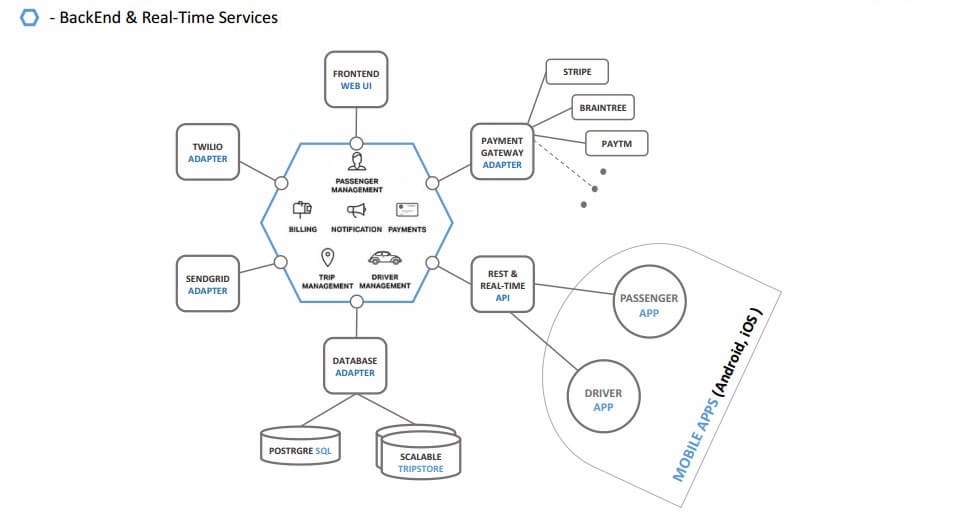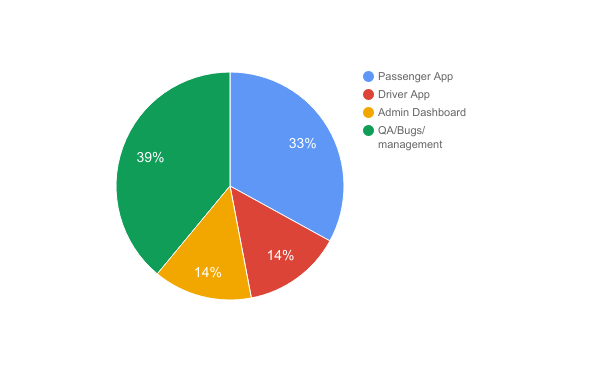How much does it cost to make an app like Uber? There’s a growing demand for Uber-like clone applications among business entrepreneurs around the globe. Mostly for taxi apps with slight modifications to Uber business model, though some strive to apply it to other industries as well. Our agenda today – how much does it cost to make an app like Uber.
How does Uber work?
First and foremost, Uber is the taxi ordering app used by millions due its outstanding service for people, as well as job opportunities. For riders, Uber has been a real blessing since 2012, as they now can book a private cab driver with one tap on the phone. The nearest car will pick you up in minutes.
Uber has 80 million users and operates in 77 countries. The service is generally 35 to 50% cheaper than traditional taxi cabs, responds faster as well. That’s why its effect to market they call ‘disruptive’. And that is the reason why many want to follow its path. Lyft, Hailo, Gett and other have already succeeded. What about the cost?
Mind, that no one is able to estimate the exact cost of developing a taxi app like Uber. It all depends on vast variety of things: app architecture and developer rates, features, country and industry, and hundreds of others.
Features
Here’s is a chart summarizing the basic features of taxi app like Uber:

Uber main features
We should note right away, that developing an app like Uber means 2 separate applications with different functionality:
- Passenger app – for those who book a taxi
- Driver app – for those who get orders and ride you to your destination.
List of features is first huge factor to the cost of taxi app development. Some of the features of both passenger and driver interface will overlap, but each has its essential ones too.
Basic features of passenger app:
- Register/login: email and/or social media login option, accounts, credit cards, payment processing;
- Booking interface: a screen to enter the address to call a taxi to, select a cab type (or specific driver), set a location for pickup;
- Tracking: to track driver’s location, to make updates during or after a ride, etc.;
- Price calculator: to check the estimated cost of a ride from point A to point B with certain cab type even before ordering;
- Payments: cashless and in-app, paid automatically via credit card, users receive an invoice to phone and email, or just plain cash;
- Push notifications: to keep users updated on order status, estimated time of taxi arrival, and other details like car model, license plate, etc.;
- Messaging, ratings & reviews, booking history.

Basic features of driver app:
- Register/profile/status: with verification (tax number) and approval by an administrator, plus online status and schedule;
- Booking: with options to accept or deny the incoming order, info on customer location and destination of a ride visible instantly, plus booking history;
- Push notifications: for order alerts, taxi booking data (location, payment, route, etc.), for order updates and/or completion;
- Navigation: e.g. using Google Maps or Google Places to get optimal directions to a customer and to his destination, could be voiced;
- Cost estimation, reports, messaging, support.
Additionally, to manage all the process and drivers from a central point an admin panel is required. It is a web (desktop) application that facilitates interactions with customers, manages ride routes, payments and all other data.
Technology to build an app like Uber
Having in mind that Uber has already disclosed its API to public and developers, and introduced the Riders affiliate program, you can also build own tailored Uber-like app. Server, mapping and payments are the three giant foundations to develop a taxi app. First off, to process hundreds of user requests, driver routes and other data you need own server.
Programming languages for backend – Node.js, Python, Java, PHP, Ruby on Rails. Another crucial element to any Uber-clone app is GPS. OpenStreetMap API for both iOS/Android can be used. Platform-specific tools in this regard for Android could be Google Maps and Google Location Services API. For iOS devices – MapKit or CoreLocation framework.
As Uber supports in-app payments via credit cards, Paypal, you may use the following gateway adapters to develop an app – Stripe, BrainTree, Paytm, PayPal mobile SDK. Technology stack for push notifications is pretty straightforward: Google Firebase for Android, and Apple Push for iOS phones. For SMS sendouts Uber went publicly with Twilio, though other cloud communication platforms, like Plivo, Nexmo, Tropo, deserve attention.
Read more on How to make a mobile app.
Cost components
Without going in detail into every possible aspect of app development, let’s briefly review big and general chunks of work that go into an app like Uber. Those components are:
- Backend development
- Web development
- Native app development (Android/iOS)
- Design
- Management and quality assurance
Backend
Constructing the infrastructure – the backend, with all connections between elements is the foundation. In quest of how to make Uber like app this is the first stage. This would be the platform itself with all the features we’ve mentioned above.
Using JavaScript, Python or Java languages developers would have to build the app’s core and link it to user interfaces, both passenger and driver app. All of that data would be stored on a single database system, like PostgreSQL, though scalable storage is more efficient. Check the simplistic version of architecture below.

In regard to timeline and resources, one can not define app’s backend accurately. Every feature in Uber like app is a painstaking work. On average, each feature may eat up 100 to 200 hours, and even more. You can hire two senior developers, or a whole team to go faster, it all depends.
Native iOS/Android
If you want to cut down the cost and create a simple taxi app like Uber, you’ll choose just one platform. This depends on your target customers. Clearly, covering both iOS and Android would be of preference. Any trusted software company is capable of developing both platforms these days.
Backend and functionality would be the same either for Android or iOS, while tools and frameworks in use would be platform-specific. For instance, Google Wallet or Apple Pay, or various PayPal affiliate services. Timeline for each platform – 200 hours at least.
Conclusion
Hourly rates vary from place to place greatly, e.g. $20-40 Asia, $40-80 Europe, $100-150 in UK/USA. Assume, we calculate the cost to make an app like Uber at median $50 rate. But remember that at ThinkMobiles we offer $30 hourly rate for mobile app development projects.
| iOS application | Android application | App for both platforms | |
| Backend | $5.000 (x2) | $10.000 | |
| Development | $10.000 | $12.000 | $22.000 |
| Design/Frontend | $9.000 | $11.000 | $20.000 |
| QA / PM | $6.000 | $7.000 | $13.000 |
| Total cost (approx.) | $30.000 | $35.000 | $65.000 |
Within general timeline of app development a passenger app (33%) and quality assurance (39%) would be most time-consuming components. While building a driver app and admin/web application would take about 14% of time each.

So, finally, how much does it cost to build an app like Uber? Or actually, how much can the cost range?
Summarizing all the factors, and making a mere approximation, the single-platform app like Uber would cost around $30.000 – $35.000 at $50 hourly rate. While a basic app for both iOS and Android would cost around $65.000 but can go higher.

